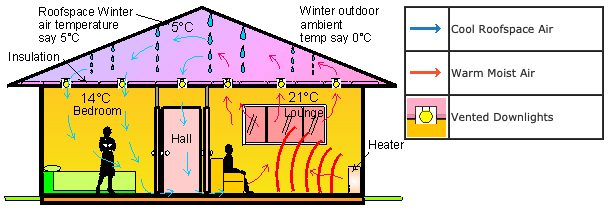VENTED DOWNLIGHTS
The Problem with Vented Downlights

Conditions…
- The lounge is warm, and occupied. Temperature is say 21°C at ceiling level.
- The roofspace temperature is say 5°C
- The Outdoor (ambient), air is say 0°C.
The example illustration above, shows how a convection air flow is started by vented down-lights in a modern home, where the roofspace is generally reasonably well sealed, (although an air flow that causes a similar effect, is also possible with a draughty tiled roof 1960s home).
Warm air is convected through the downlight vents into the roofspace. When this air contacts the cold surfaces in the roofspace, the moisture it contains condenses and causes roofspace dampness and condensation.
The air flow into the roofspace causes a “negative pressure” in the living room, so air is drawn in from other areas in the house to replace air leaking into the roofspace from the lounge. This “make-up” air enters the bedroom etc via any downlights which are off.
Roofspace air is polluted air.
Problem …
- The heat dissipated by down-lights is designed to be vented into the ceiling space by a “convection air draft” through the down lights, that automatically occurs as soon as the down-lights are switched ON.
- Warm air from the lounge passes through the down-lights, into the roofspace. This causes a “negative pressure” in the lounge. The negative pressure is “made up”, by air leaking into the lounge under doors or through virtually any other opening or gap between the lounge and the hall. This in turn causes a negative pressure in the hall, and so on to the bedroom, or other rooms where there are down-lights that are switched OFF.
- Unfiltered, contaminated roofspace air is literally “drawn” from the roofspace, down through the down-lights that are switched OFF, into the bedroom, and through the hall, to eventually “make up” for the air that is flowing from the lounge, over the down-lights that are switched ON, and into the roofspace. So your home is ventilated with foul roofspace air, by the convection air currents caused by vented down lights
- This is uncontrolled ventilation and energy waste. We have measured the air flow through a typical vented down-light at approx 9 Litres per second. 6 down lights equal 54 litres per second. An HRV can ventilate an entire average home with this volume of air.
- Vented down-lights completely negate the operation OF ANY VENTILATION SYSTEM.
- Worse, the lounge air is warm, stale and humid. When this air enters the roofspace it rises to the highest point, (usually the underside of the roof cladding). The roof cladding is “chilled” by the outdoor air temperature of say 0°C. This causes the moisture in the air from the lounge room to condense on the underside of the roof cladding in the roofspace.
Condensation drips from the underside of the roofing cladding, and on to the ceiling insulation material, (some will run down the underside of the roofing to create a specialised dripping in one particular place).
We have seen several homes in various parts of NZ, where so much water has accumulated from dripping on to the ceiling insulation, that the plasterboard ceiling lining has collapsed under the weight of water, caused by roofspace condensation. - Vented downlights upset the performance of any controlled ventilation system. There are many brands and types of downlight. Here is a simple description:
– “Full circle” open venting — these are the lowest cost and cause problems.
– Others have minimal venting
– The best are fully sealed. - With existing downlights, a simple way to identify is to switch the downlights ON, then inspect from inside the roofspace, if you can easily see right through the down light, then it is most likely a vented down light. Hold your hand over the downlight — if there is a draft of warm air, it is the vented type and will cause the problems outlined.
- Unless you change the down lights to un-vented (approved) types, it is literally a waste of time and money to install a ventilation system.
- Further, if you home has been built since 1991, it is required to comply with energy efficiency regulations. With open vented down-lights it is very unlikely that the home will comply with the energy efficiency requirements for Building Consent Compliance. Energy efficiency standards are met when the living space “envelope” is complete. By installing open vented down lights, the envelope is “broken” and the standard of energy efficiency is significantly reduced, because heat energy from the home is wasted away.
- NEVER, NEVER, NEVER, cover or restrict the air flow that is designed to pass through a vented down-light, (or allow any trades-person to) ie… covering it with ceiling insulation.
This is regarded as unauthorised modification to an approved electrical fitting, and if any fire or scorching damage occurs, your home insurance may be invalid. Worse, any home fire may be life threatening.
DO NOT TAKE CHANCES WITH DOWNLIGHT MODIFICATIONS.
CONTACT US.

Email: info@avonelectric.co.nz
Products are New Zealand made by Avon Electric Ltd.
Ph: 03 381-5595 - Fax: 03 381-5596